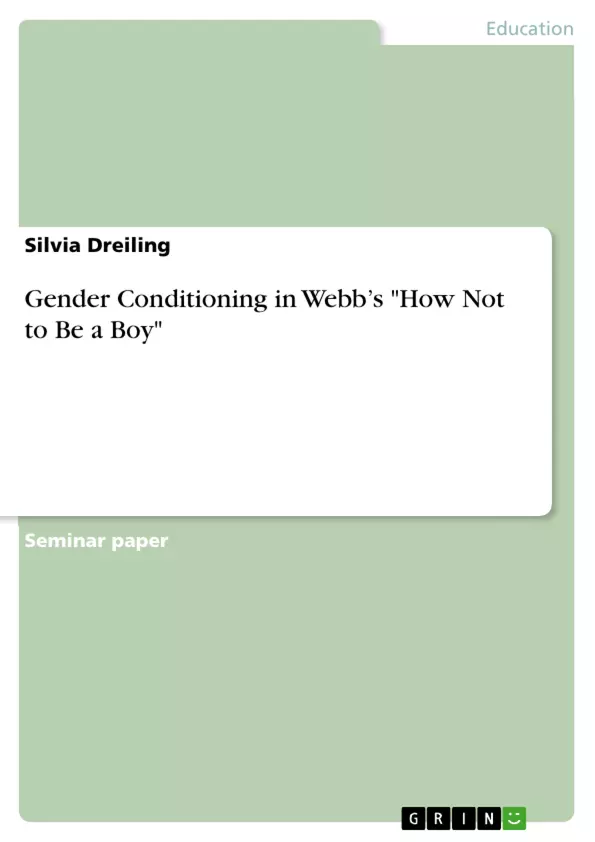Drawing attention to gender issues and gender conditioning is crucial as “gender is one of the central organising principles around which social life revolves.” (Baker 4) Boudet et al. suggest that gender norms even rest upon other social norms which organise societies and community life. Besides, it can be said that gender is a component of a persons’ identity, along with other components like age, social class, or religion.
In Robert Webb’s autobiography How Not to Be a Boy, gender is the main topic. Webb particularly draws attention to the gender conditioning of men and describes what it takes to be a man. Growing up in the 1970s, he shares his experiences of gender norms, roles, and attitudes from early childhood to adulthood. Webb himself has never been good at being a boy or man, as the title suggests. In How Not to Be a Boy, Webb addresses gender issues such as not fitting one’s gender role, which have influenced his own life and identity, and gives a clear message that addressing the gender conditioning of men will improve life for all.
He emphasises that gender equality can only be achieved if we realise that men or boys are gendered, too, and are unavoidably involved in gender issues. In this paper, the gender conditioning of men is investigated. First, a theoretical framework is presented, which includes definitions of gender and explanations of how gender has developed, in the last decades. Then, gender in Webb’s autobiography is analysed by drawing on examples from the book, and finally, there is a summary of the main findings.
Inhaltsverzeichnis (Table of Contents)
- Introduction
- Theoretical Framework
- Presentation of Gender in Webb
- Conclusion
Zielsetzung und Themenschwerpunkte (Objectives and Key Themes)
This paper investigates the gender conditioning of men, using Robert Webb's autobiography, How Not to Be a Boy, as a primary source. The objective is to analyze how societal expectations and norms shape masculine identities and to explore the implications of these conditioning processes.
- Gender definitions and their evolution
- The impact of societal gender roles on individual identity
- Challenges to traditional masculinity and the emergence of new gender norms
- The role of feminism and social movements in shaping gender dynamics
- The significance of addressing gender conditioning for achieving equality
Zusammenfassung der Kapitel (Chapter Summaries)
Introduction: This introductory chapter sets the stage for the paper by highlighting the ongoing prevalence of gender inequalities globally. It emphasizes the importance of understanding gender conditioning in men, noting the shift from a focus solely on women's issues to a growing recognition of the need to address gender issues affecting both men and women. The chapter introduces Robert Webb's autobiography, How Not to Be a Boy, as a case study for exploring these issues, specifically focusing on the author's personal experiences with gender norms and expectations.
Theoretical Framework: This chapter delves into the complexities surrounding the definition of gender, acknowledging the ongoing debate and evolution of its meaning. It contrasts sex (biological) with gender (social and cultural), exploring how gender roles and expectations have changed over time, particularly due to the influence of feminist movements. The chapter examines the shifts in power relations, production relations, sexual relations, and sexual identities, highlighting the modifications in normative frameworks associated with gender and the social sanctions associated with nonconformity.
Schlüsselwörter (Keywords)
Gender conditioning, masculinity, gender roles, gender equality, feminist theory, Robert Webb, How Not to Be a Boy, social norms, gender identity.
Frequently Asked Questions: How Not To Be A Boy - A Language Preview
What is the main focus of this academic paper?
This paper analyzes the gender conditioning of men, using Robert Webb's autobiography, "How Not to Be a Boy," as a primary source. It investigates how societal expectations and norms shape masculine identities and explores the implications of these conditioning processes.
What are the key themes explored in the paper?
Key themes include gender definitions and their evolution, the impact of societal gender roles on individual identity, challenges to traditional masculinity, the role of feminism in shaping gender dynamics, and the significance of addressing gender conditioning for achieving equality.
What is the structure of the paper?
The paper is structured into an introduction, a theoretical framework chapter, a chapter presenting gender in Webb's autobiography, and a conclusion. It also includes a comprehensive language preview with a table of contents, objectives and key themes, chapter summaries, and keywords.
What is the role of Robert Webb's autobiography in this research?
Robert Webb's "How Not to Be a Boy" serves as the primary case study. The paper analyzes Webb's personal experiences with gender norms and expectations to illustrate the broader themes of gender conditioning and the challenges to traditional masculinity.
What theoretical framework is used in the paper?
The theoretical framework explores the complexities of gender definition, contrasting sex (biological) with gender (social and cultural). It examines how gender roles and expectations have changed over time, influenced by feminist movements and considers shifts in power, production, sexual relations, and sexual identities.
What are the key takeaways from the chapter summaries?
The introduction establishes the context of ongoing gender inequality and the importance of understanding gender conditioning in men. The theoretical framework chapter delves into the complexities of defining gender and its evolution. The chapter on Webb's autobiography analyzes his experiences within the context of the established theoretical framework.
What are the keywords associated with this paper?
Keywords include: Gender conditioning, masculinity, gender roles, gender equality, feminist theory, Robert Webb, How Not to Be a Boy, social norms, gender identity.
- Quote paper
- Silvia Dreiling (Author), 2018, Gender Conditioning in Webb’s "How Not to Be a Boy", Munich, GRIN Verlag, https://www.grin.com/document/496843



